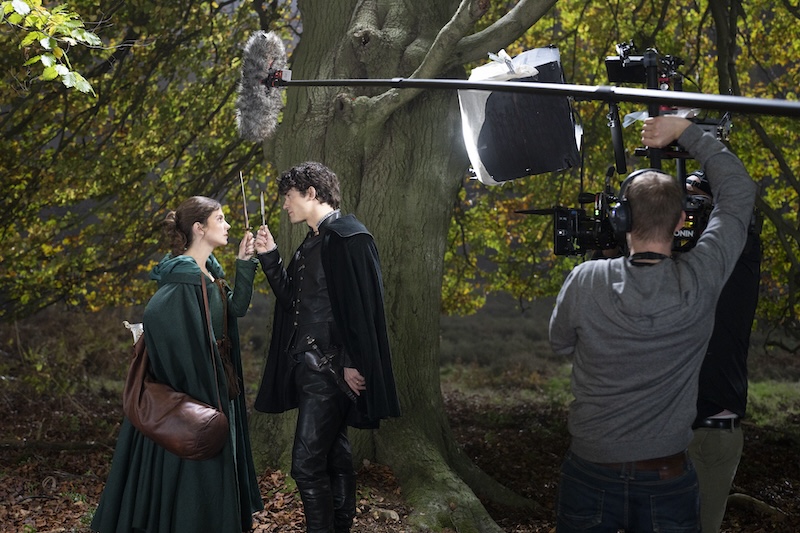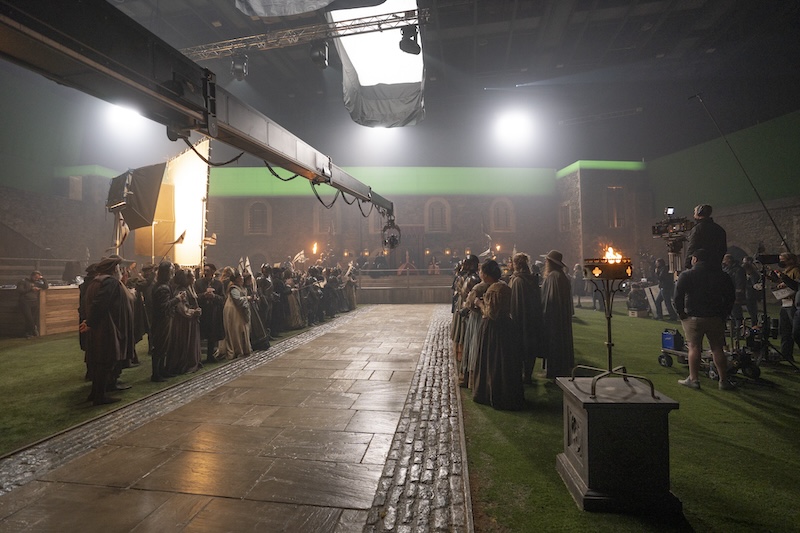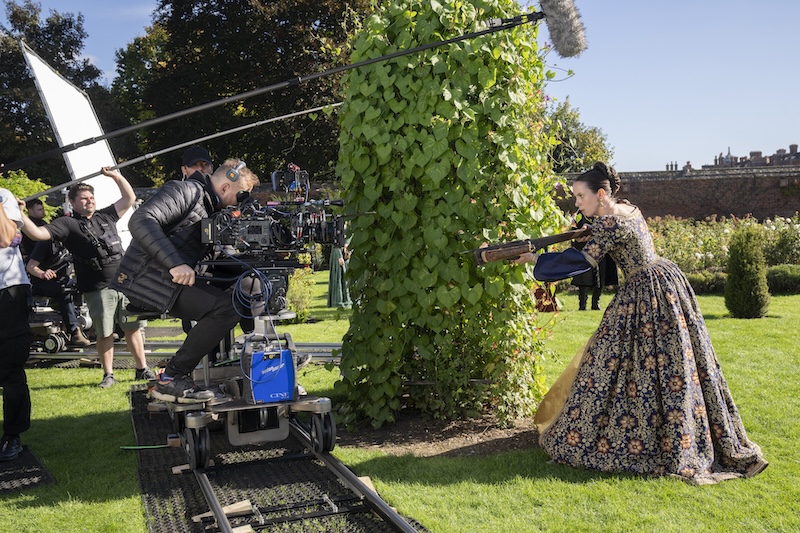“Right between the tits, every time!”
If this doesn’t sound like the chatter you’d expect from the soundstage of a lavishly appointed Tudor-set period piece, you don’t know My Lady Jane.
Adapted by showrunner Gemma Burgess from a saucy YA fantasy of the same name, the Prime Video live-action series—its inaugural season streaming in its entirety as of June 27—is, by design, not your proverbial mother’s Tudor drama. Scripted by Burgess and Meredith Glynn (Supernatural) to reflect the whippy, tongue-in-cheek prose originally put to page by Cynthia Hand, Brodi Ashton, and Jodi Meadows, and directed primarily by Only Murders in the Building’s Jamie Babbit, this take on Lady Jane Grey’s tragic 1553 nine-day reign is custom-built to be a bit sharp, a bit sexy, and a lot nervy. Think less Wolf Hall and more Blackadder; less Mary Queen of Scots and more The Princess Bride.
Oh, and did I mention? Half the characters turn into animals. (And it’s important, I think, that I do, as neither trailer released earlier this month quite managed to, and it’s a pretty pivotal part of this take on Jane Grey’s story.)
Unfortunately, that half of the cast wasn’t on the show’s London set the day I visited as part of a press tour the week before Christmas, all the way back in 2022. Or rather, the human actors behind each of those characters are on set (shh, no spoilers on specifics!), but not their animal counterparts.
Naturally, it’s something of a disappointment when we learn that our visit will be animal-free. Those of us who had read (or in my case, re-read) the book in preparation have arrived to Pinewood Studios in an Ethian frame of mind—Ethian being the term for people who can change into animals in My Lady Jane’s world, with the Ethian/non-Ethian divide standing in for the Protestant/Catholic division that wracked 16th-century England in our own timeline, and ultimately led to the real Lady Jane’s tragic demise. Not only does My Lady Jane promise its exceptional heroine a happier ending, but it does it with horses, hawks, foxes, and ferrets! We’ve arrived ready for ferrets.
Oh, and did I mention? Half the characters turn into animals.
Alas, it’s not to be. We do at least learn that Burgess, Glynn and Babbit aren’t planning on using any CGI animals for this story, their comedic sensibility being fully lo-fi and analog. (“Almost like What We Do in the Shadows,” one of them tells us, as a comp.) We also learn that the production department contracted the Game of Thrones horse outfitter for the equine half of the show’s animal cast, and that the series’ hero horse is being played by the same animal that galloped across the screen as Indy’s steed in the new Indiana Jones. What a coup for My Lady Jane! But also, what a bummer for us.
Still, it’s hard to hold on to much disappointment as we’re taken from the the tavern-cum-stable-cum-totally different tavern-cum-prop closet where they’ve set up space for cast interviews and lead us through to Pinewood’s cavernous main soundstage, where it seems as though all the best bits of Tudor England have been recreated in painstakingly intricate detail and then smushed together to make a single, massively labyrinthine set.
Here’s a hammered brass vase of dried bachelor’s buttons, yarrow, and feathery prairie grass; here’s a massive four-poster bed covered in fur throws, with another brass bowl of fresh (wax) grapes and sticky (wax) puddings alongside. Here’s a working fireplace under an intricately carved portrait of a lion and bear rampant on its stone (plaster) mantel; here’s a whole room draped in brightly colored, custom-woven unicorn tapestries. Here’s another working fireplace, this time in Jane’s childhood home, the bare flagstone floor strewn in pillows, the carved molding around the ceiling cordoned in dried flowers and herbs. Here are her tables filled with 16th-century books in a way that’s not necessarily period-accurate (books being too expensive to amass, even for nobility!), but is certainly true in spirit to the real Jane’s deep intellectualism and knack for languages.
Down we go through a dark, vaulted corridor that looks like, and has the chill of, carved stone, but at a touch is clearly painted plaster. Past a series of warped stained glass windows (a crafting process that took at least five weeks) through which we can see exterior screens painted by hand to look like old brick, past a series of tapestries that used to be crafted by a well-paid scenic painter, but are now done with fancy technology. (Calling Captain Ludd to stand in solidarity with scenic painters!)

And now we’re at Mary’s room, which we’re told will become someone else’s room when “something happens on the show… I’m not at liberty to say,” but which is outfitted for the moment in goth-y (but not gothic) studded black leather and moody dark-timber furniture. Like Jane’s quarters, Mary’s room also has a working fireplace, but it’s nothing compared to the one we’re led to in Bess’s room, which is mobile enough to slide from one part of the set to another (to anchor yet another character’s room), and which contains a secret hidey hole for Bess (Abbie Hern) to hide her most precious trinkets—custom-crafted Anne Boleyn necklace included.
Cleverly, Bess’s hidey hole was built to fit a camera lens through from the back. Because of course when you’re playing architect for a television set, planning for what the camera can see is just as important as making the set look good. This is also why so many of the sets—which all have partial and even occasionally full ceilings, the better for a sense of lived-in realism—have camera holes punched out in various places, and why so much of the prop furniture was chosen with an eye for texture.
Cromwell’s team has swathed the walls in crimson and gold tapestries; the ceiling is hung with golden branched chandeliers; the floor is strewn with delicate gilt petals.
“We were very keen, with set-dec, to have furniture that had a lot of engraving and carving on it,” explains Gina Cromwell, one of our two tour guides and My Lady Jane’s lead set decorator. They also painted in gold embellishments pretty much anywhere they could. “An awful lot of the show is set at night, and so when we develop a set, we’re thinking about how it’s going to look in the dark—because there’s going to be a lot of candlelight, there’s going to be a lot of twinkling, and we need to reflect [that light] off of things.” This, she tells us, is also why there are so many spectacular and working fireplaces. It’s all about that twinkle.
Which, I suppose, brings us back to the tits of it all. Because the main scene being shot that day is Jane’s glittery coronation ball, set in the castle’s glittery ballroom. Cromwell’s team has swathed the walls in crimson and gold tapestries; the ceiling is hung with golden branched chandeliers; the floor is strewn with delicate gilt petals. The candles in the chandeliers are electric and flicked on; the candles on the dais at the front of the room are real, but unlit. You better believe the room twinkles.
While we’re amidst that twinkling, the set is empty—Cromwell has taken advantage of a quick filming break to sweep us through. But once our scrum is back in the barn-cum-tavern-cum-green room on the other side of the building, we watch through a monitor as a bespangled cast files back in from the wings. Not everyone’s dressed in head-to-toe gold, but most outfits have at least one feature that catches the candlelight.
And then the show’s shining romantic leads come into frame: Guildford (Edward Bluemel), his black velvet jacket sporting a gold cord and leaf-pattern brocade, and Jane (Emily Bader), her whole gown made of gold, her shoulders and neck framed by a tall golden mesh ruff that through the tiny monitor looks awfully familiar.
The actors find their marks, the crew goes quiet.
Action!
The camera pans in from behind Jane’s back. Guests turn to look. Golden petals fall.
From somewhere in the party crowd, we hear: “Try the dolphin, it’s in season!”
Cut!
A good reminder: Gilt petals notwithstanding, My Lady Jane is, above all, a comedy.
The chatter of a busy soundstage rises back up, and it’s about now that we hear the tits line through the monitor. I note it down as fun color for the set visit write-up that I don’t yet know will take nearly eighteen months to be relevant (Hollywood!), presuming it’s the actors goofing around with each other as the camera resets.
And given the collegial chaos we’re about to be met with as the show’s core cast is delivered to our not-a-tavern press scrum for pairs interviews, that’s almost certainly what it is. Still, one of the series’ trailers features Anna Chancellor’s Lady Frances Grey informing her youngest daughter that after gamesmanship, her number one skill is (wait for it) fellatio. So really, who knows?
So maybe a bit of Wolf Hall, after all. Just, funny. And possibly, one can hope, with real wolves.
The cast, probably. But they’re well-trained and, sitting down with us in turns later that afternoon, give very little away. Well, at least about the most spoiler-y parts of the story they’re helping to tell. About their characters, though, and their relationships both on and off screen? That, they’re much freer with.
Jordan Peters (King Edward) and Michael Workeye (Archer, an anti-monarchist revolutionary) are brothers in the mantle of leadership, even if their characters are leading from different sides of the sword. Bader and Bluemel are creative partners with the fullest trust in one another, a bond that’s clearly been honed through scenes of intense fighting, spicy flirting, and whip-fast banter (in Latin). Rob Brydon (Lord Dudley) is the production’s comedic elder statesman, his improv game even on a bad day setting the bar astronomically high for everyone else.
And then there’s Kate O’Flynn and Dominic Cooper, who play the series’ most malevolent baddies (Queen Mary and Lord Seymour) and whose twenty-seven- minute conversation with us goes so deep into left field that it’s saved in my files as simply “Kate and Dominic Chaos.” Theirs is “a deviant sibling relationship,” to hear O’Flynn describe it, or “a deviant sibling relationship… with some undertones of… malevolence?” to hear Cooper do the same. This is ostensibly meant to apply to their characters, but as the pair spend the next half-hour talking over, teasing, and needling one another, it’s hard to tell where art ends and the real world begins.

One example: asked to take stock of their characters, O’Flynn describes Mary as a “powerful frayed nerve”—a sleek actorly assessment that sends Cooper into a tailspin to come up with something half as good for Seymour. “A furious… puppy dog,” he spits out, uncertainly. “He’s always desperately trying to get what he wants, but then also he’s quite puppy dog-ish. I don’t know whether I’m meant to be playing that, but I am. Is that right?” he asks O’Flynn as he simultaneously barrels on without giving her space to answer. “An angry puppy dog! A loose fuse puppy dog! I’m trying to think of something as good as yours, but I don’t know.” He keeps going: “He’s always referred to as ‘furious,’ but I don’t even know who he’s furious wit—oh! I know who he’s furious with: It’s Dudley. He hates Dudley, can’t stand him. Though not in real life, of course.”
An hour later, in real life, Dudley himself calmly weighs in: “Like having a puppy who hasn’t been properly housetrained.”
And that’s Seymour that Brydon’s describing? Nope—Cooper. But Brydon can’t lie: he loves the puppy energy. “Charming and enchanting and delightful,” he says. “I’ve really enjoyed playing scenes with him.”
”It’s a chance for people to take an interest in what really happened, to learn the history we aren’t telling.”
As for the on-screen dynamic between their semi-fictional baddies, Brydon’s also a fan there: “Oh, we’re sort of trying to be very polite to each other on the surface, but then there’s a lot of, what’s the word I’m looking for?”—he pauses for effect—“Beef, as the young people would say: beef. Some of you may not know that word, that’s what young people use. Anyway, he sets me up as a poisoner, and then I have to beg for my life, and then I wriggle my way out of that, and then later we see each other back in court and he says something like, bygones? Chums again? And that’s great fun to play.”
So maybe a bit of Wolf Hall, after all. Just, funny. And possibly, one can hope, with real wolves.
As disarming as O’Flynn and Cooper’s time with us is, though, it’s Bader who gives us the behind-the-scenes scoop of the trip, as it turns out that Jane’s gold ruff looks so familiar because it is: it’s literally the same piece worn by Gwyneth Paltrow in Shakespeare in Love, preserved in Pinewood’s costume storage for twenty-four years only to find a second life on Bader’s shoulders.
“They sent a picture to Stephanie [Collie], our costume designer, and said, this is what we want,” Bader is already telling us before she and Bluemel are even fully settled. “And she’s like, well, we do have that exact piece. So they made another one that was similar, but [eventually] we were like, oh gosh, we’ve got to use the original!”
This feels like the story of My Lady Jane in a nutshell: incredible attention to narrative and character detail, backed by the kind of pre-2023 money and studio support that makes just about any request possible. You want Gwyneth Paltrow’s gold Shakespeare in Love ruff? Done. You want Indiana Jones’ literal horse? No problem. You want to shoot a mounted battle scene on horseback on the rainy moors for a whole week, then recreate the entire set-up against a bluescreen back at Pinewood? Absolutely! The real Lady Jane may not have survived long enough to hit a double-digit number of days as Queen, but Gemma Burgess’s Jane’s got the world on a gilt platter.
For Bader, this feels right. There is an innate tragedy in a queen who only got to live for nine days after taking the throne, she agrees, when a British journalist asks her if that was a detail that struck her about her character. But as an American (spoiler alert, for anyone fooled by her flawless Keira Knightley impression!), Bader was even more struck by how little we actually know about Jane at all five hundred years after her death.
“I went to the Tower of London and asked if they had anything on Lady Jane Grey,” she says, “and they said, Jane Austen? And it was so shocking to me, that a woman who was Qqueen of England and Ireland and was killed for it, for her life to just end up a footnote on a page for some people.” There are some helpful history books out there, Bader allows, with details that they were able to draw from to shape Jane on the screen—for example “we know she was known for being one of the most educated women of her time, and that she was a polyglot”— but still, those details only scratch the surface. “She was just a fascinating woman who didn’t get the time to show the world how brilliant she was.”
Here Bluemel reminds us that when it comes to the real Guildford Dudley, a footnote, literally, is the extent we know about him: “Sixteen-year-old boy, married Lady Jane Grey, died.” Which is to say, he’s just as excited to get to imagine a fuller life for Guildford, even if it is, per his audition sides, as a leather-clad ”Tudor-era Harry Styles.”
“Obviously the way that we are telling it is heavily, heavily embellished,” he says. “But that means it’s also a chance for people to take an interest in what really happened, to learn the history we aren’t telling.”
At the end of the day, that’s Burgess, Glynn and Babbit’s goal, too—to subvert the text of what little history has to tell us about Lady Jane Grey and make her real in the process. Even if that process includes ferrets; even if it hits us right in the tits, every time.
_______________________________
All eight episodes of My Lady Jane, Season 1, are now streaming on Prime Video.
